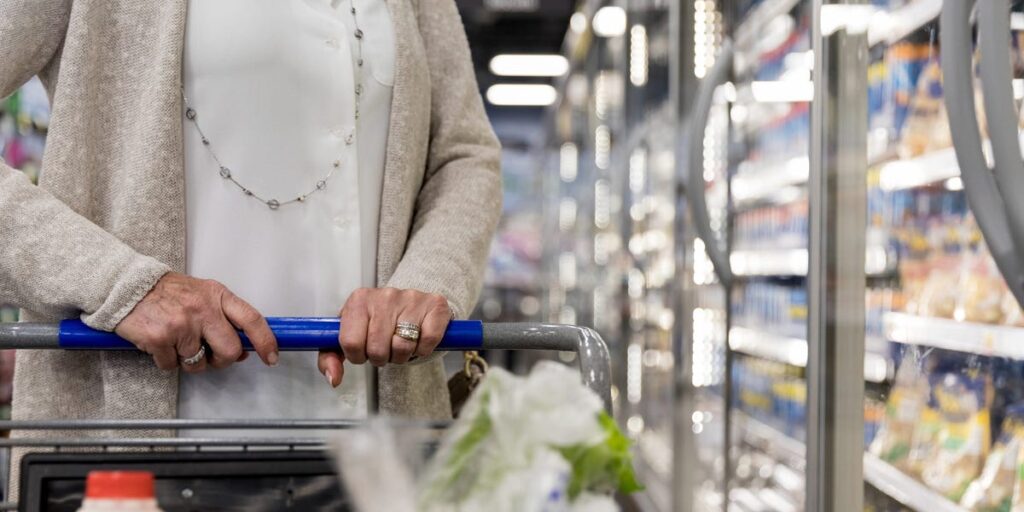Three cans of SpaghettiOs for $1 each, a dozen eggs for $2.99, a half gallon of milk for $2.59. She adds bread, soup, potatoes, chili mix, graham crackers, cereal bars, clementines, toilet paper, some frozen vegetables, and canned chicken — the fresh stuff is expensive.
It comes to $83.02.
Dacus goes shopping near her home in Robinson, Illinois — a city 200 miles south of Chicago — on the fourth Wednesday of every month after her husband Stephen cashes his Social Security check. She hopes the food will last them a full 30 days, but she inevitably has to stop at Walmart a few times to fill in the gaps.
Granola for $5.34, bell peppers for $2.88, two bottles of butter pecan coffee creamer for $7.94, and a new vacuum bag for $8.77. That’s an additional $53.39.
Dacus and her husband have to stick to a tight budget: their household only receives $23 a month from SNAP. They must rely on their combined $2,140 Social Security income for the rest and any other expenses they have since they’re both retired. The average American household spends $475 a month on groceries plus $303 on restaurants and takeout, according to the latest available US Bureau of Labor Statistics report on consumer expenditures in 2022.
There are over 40 million Americans experiencing food insecurity. SNAP provides relief for many households living paycheck to paycheck. But some struggling families, like Dacus’, don’t receive enough help, or their income is considered too high to receive any help at all. ALICEs — people who are asset-limited, income-constrained, employed — feel especially left behind by food assistance programs.
According to the Pew Research Center, about 13% of Americans, or 22 million households, are enrolled in government food benefits.
Anything helps, Dacus said, but her SNAP allocation “barely covers one meal.”
“The man called me and told me, ‘Oh, we’re going to get you $23 a month.’ And I laughed,” she said. “That’s pitiful. That’s really pitiful.”
With limited SNAP dollars, Dacus relies on food pantries
Dacus is a good cook — she used to love making pot roast when she could afford it — and can usually make a meal out of whatever miscellaneous ingredients she and Stephen have in their cupboard. She typically makes crockpot meals, casseroles, or other dishes that she can stretch for more than one meal. But $23 a month in food benefits isn’t even close to affording what they need to eat.
Often, Dacus said a full month of food and household products can run them about $200, plus an additional $30 to $50 a week when they run out of things. They struggle with their other household bills, are in nearly $10,000 in credit card debt, and have drained their savings in order to pay for food and healthcare.
“We’ve used our credit cards within the last three and a half years to buy groceries and things that we needed,” she said, adding that she and Stephen’s low credit score has now made it difficult to qualify for housing and car payments.
To avoid going hungry, Dacus said she has to rely on local food pantries. They pick up canned goods and packaged food. But there aren’t many food pantries near her house, and the ones in driving distance are open for limited hours. Even when they can go to the pantry, Dacus said the food is unhealthy and sometimes spoiled.
SNAP benefits don’t always align with household needs
America’s SNAP program provides low-income households with money to grocery shop, and the qualifying criteria is based on the federal poverty line. The allocation can also be affected by earned-income taxes, and the number of children or older adults in a household. What’s more, the costs of groceries can vary widely based on a person’s location.
An individual with a monthly gross income lower than $1,580 can receive a maximum of $291 monthly from SNAP, and a couple with a monthly income lower than $2,137 can receive a maximum of $535, according to the US Department of Agriculture. Yet, many households like Dacus’ don’t receive the maximum because their income isn’t low enough.
There are also limitations on how SNAP dollars can be used. The money covers basic food products like milk and bread, but it cannot be used to purchase dish soap, toilet paper, laundry detergent, vitamins, feminine products, over-the-counter medicine, or pet food.
Groceries are just part of the $38,268 the average couple in Robinson, Illinois needs to survive every year, which includes the cost of housing, utilities, healthcare, transportation, and unexpected expenses, according to United Way. For a family with two school-age children, that number becomes $61,632. This budget doesn’t leave any room to build savings or prepare for retirement.
It’s also more difficult for childfree adults, or adults whose children are no longer minors, to qualify for food assistance. Dacus said she and her husband have to rely on SNAP and food pantries because she can’t access other programs like WIC (Special Supplemental Nutrition Program for Women, Infants, and Children), the child tax credit, and parts of the earned-income tax credit.
“We don’t get ahead at all,” Dacus said. “We take two steps forward and three back.”
Are you experiencing food insecurity? Are you open to sharing your experience with SNAP or grocery shopping? If so, reach out to this reporter at allisonkelly@businessinsider.com.
Read the full article here
















